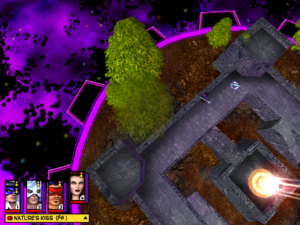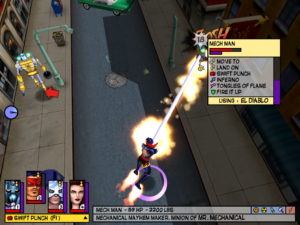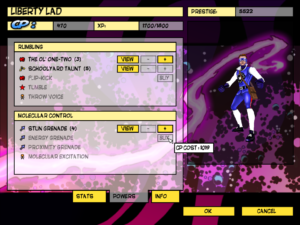Freedom Force: Ending
 The ending of Freedom Force takes place in the Timemaster’s realm, an Ethereal-Void-type place. I’ve described this sort of environment as “Ditkoesque” before, but the styling here is still more Kirby than Ditko. The action takes place on a series of platforms in the shape of enormous rotating clock-gears, each replicating a small section of an environment either encountered earlier or, in one case, merely hinted at. Each gear contains a portal to the next, but it only opens up when you’ve defeated all the enemies there. It’s all a grand recapitulation of the game as a whole, with reprises of all the bosses, like the final dungeon in a Zelda game. It’s not quite the same as the first encounters, though, because all you really have to do to defeat the bosses this time around is knock them off the gear, which can be done with knockback moves, or, more easily, with explosions. Mind you, the same explosions can knock your own guys off if you’re not careful, but that just means you have to learn your limits.
The ending of Freedom Force takes place in the Timemaster’s realm, an Ethereal-Void-type place. I’ve described this sort of environment as “Ditkoesque” before, but the styling here is still more Kirby than Ditko. The action takes place on a series of platforms in the shape of enormous rotating clock-gears, each replicating a small section of an environment either encountered earlier or, in one case, merely hinted at. Each gear contains a portal to the next, but it only opens up when you’ve defeated all the enemies there. It’s all a grand recapitulation of the game as a whole, with reprises of all the bosses, like the final dungeon in a Zelda game. It’s not quite the same as the first encounters, though, because all you really have to do to defeat the bosses this time around is knock them off the gear, which can be done with knockback moves, or, more easily, with explosions. Mind you, the same explosions can knock your own guys off if you’re not careful, but that just means you have to learn your limits.
There’s a very nice feel of finality to this whole sequence. You know that it all ends here, or… it all ends. No need to worry about Prestige or experience points: you’re as advanced as you’re ever going to be, and you just have to hope that it’s advanced enough. The whole mission consists of twelve gears (including the larger one where the final boss fight takes place) spread out over four levels. The four heroes you pick at the beginning of the first of those four levels are the last heroes you’ll ever use, so the decision feels fairly momentous.
Ultimately, I think any team could finish the game, but certain powers definitely make it quicker and easier. The team I chose consisted of Minuteman, Bullet, El Diablo, and Eve, which turned out not to be an ideal combination, but it all worked out okay. I’ve described Minuteman and El Diablo before. Bullet is the team’s speedster, and an asset to any mission, partly for his mere ability to get places first and hit enemies two or three times before they can hit back, partly because he can gain the power to “Energize” other characters, making them regain energy more quickly than normal. He also by this point had a good charging knockback move for shoving enemies off gears. Eve is a mystically-aware primitive woman, heavily involved in the Pan arc, skilled at archery. I mainly included her because she had finally learned the Acid Arrow move, which seemed worth trying out, but in the end, she was more useful for a debuff that temporarily blinds opponents, making it much more difficult for them to hit with ranged attacks. El Diablo’s role in the party was creator of explosions and chief recipient of Bullet’s energizing. Minuteman just sort of ran around hitting minions — he was by far the least useful of the four, especially in the final boss fight, where he basically couldn’t get close enough to make an attack. I’d definitely swap him out for someone else if I had to play the whole thing through again, but since he was the very first of the heroes, it seemed fitting that he be on hand at the very end as well.
And that’s that. Just in time, too: I shortly depart for Seattle, to attend my second PAX this year (and in my entire life). Fortunately, the next game I have on my docket is one for the Gameboy Advance, suitable for play during transport, or while waiting on line, if the lines are anywhere near as insanely long as they were at PAX East. As usual, I’ll also be bringing first-generation Pokémon in a vain hope that someone reading this blog will be there and interested in doing trades.
 Comments(0)
Comments(0)
